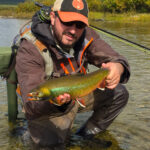The Best Anglers Never Stop Learning
The Best Anglers Never Stop Learning
The Best Anglers Never Stop Learning
The Best Anglers Never Stop Learning
I just got back from a trip to the Florida Keys, and while I had some shots at bonefish and permit, I really struggled with my presentations. Sometimes I cast too far ahead, other times too close, and a few times I spooked fish by stripping too aggressively. When you’re sight fishing on the flats, how do you make the perfect presentation to moving fish?

Sight fishing on the flats is one of the most rewarding and challenging experiences in fly fishing. The difference between getting an eat and getting ignored often comes down to how and where you present your fly.
The key to great flats fishing presentations is reading the fish. Are they moving fast or slow? Are they aggressive or cautious? Adjust your lead, strip speed, and fly movement accordingly. The more time you spend watching how fish react, the better you’ll get at making the perfect cast.
No recommended resources available.
"*" indicates required fields
Sign up for full access to the Learning Center
and all the FlyBrary Content.

payment methods accepted
Copyright © 2003 – 2025 MidCurrent LLC, All Rights Reserved.
Copyright © 2003 – 2025 MidCurrent LLC, All Rights Reserved.